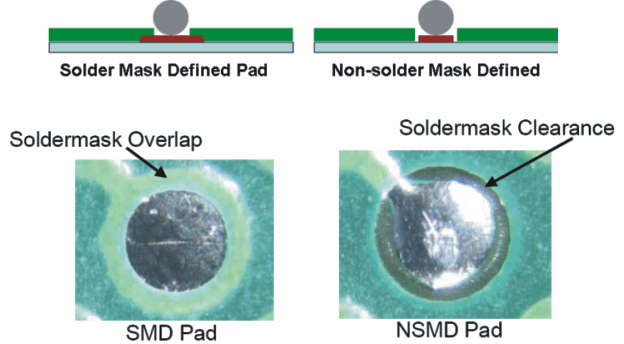SPRAAV1C May 2009 – March 2020 AM3703 , AM3715 , OMAP3503 , OMAP3515 , OMAP3525 , OMAP3530
-
PCB Design Guidelines for 0.4mm Package-On-Package (PoP) Packages, Part I
- Trademarks
- 1 Using This Guide
- 2 A Word of Caution
- 3 A Team Sport
- 4 Be Wary of Quotes
- 5 Don’t Forget Your CAD Tools
- 6 Metric Vs English
- 7 PCB Fab Limits
- 8 Routing and Layer Stackup
- 9 OMAP35x 0.4mm Pitch
- 10 Pad Type
- 11 PCB Pad Dimensions for 0.4mm BGA Package
- 12 Multiple BGA Packages
- 13 Etch Traps and Heat Sinks
- 14 Vias and VIP
- 15 Laser Blind Vias
- 16 Filled Vias
- 17 Know Your Tools
- 18 BeagleBoard
- 19 BeagleBoard Views
- 20 OMAP35x Decoupling
- 21 PCB Finishes for High Density Interconnect (HDI)
- 22 Real World Second Opinion
- 23 Acknowledgments
- 24 References
- Revision History
10 Pad Type
It is important to understand the pros, cons, and unknowns concerning the two most common types of solder pads. Figure 7 shows the solder-mask-defined (SMD) and non-solder-mask-defined (NSMD) pads.
 Figure 7. Solder-Mask-Defined (SMD) and Non-Solder-Mask-Defined (NSMD) Pads
Figure 7. Solder-Mask-Defined (SMD) and Non-Solder-Mask-Defined (NSMD) Pads Industry reliability studies have revealed that NSMD-type pads are highly recommended for most 0.5mm pitch BGA applications. However, there is a problem with this approach at 0.4mm pitch.
Real-world assembly experiments with the BeagleBoard and the OMAP35x EVM revealed a tendency for solder bridging between pads when NSMD were used. There was insufficient solder mask webbing between the pads to ward off bridging. Therefore, a SMD design was used, which resulted in much better assembly yields with no solder bridging.
Talk to your board fabricator and your board assembly house and learn of their experiences and preferences before deciding which type of pad design you will use. Be prepared to change your ideas about pad definitions as your experience grows with 0.4 mm pitch parts.
NOTE
Based on experience with both the BeagleBoard and the OMAP35x EVM, the use of solder-mask-defined pads is recommended.